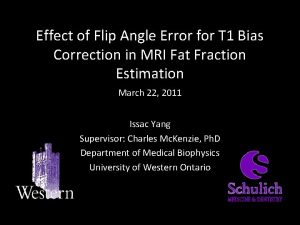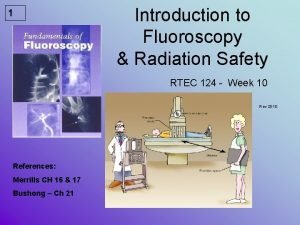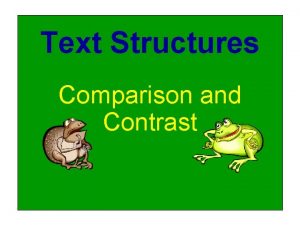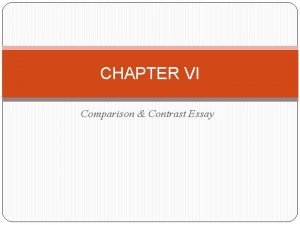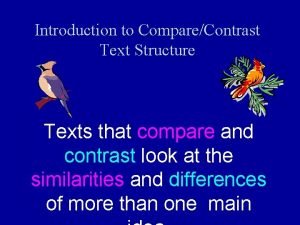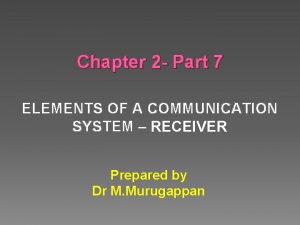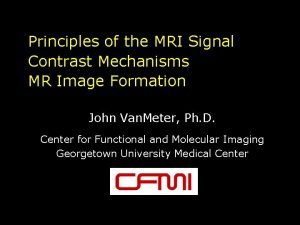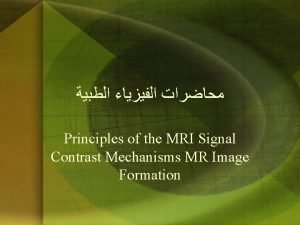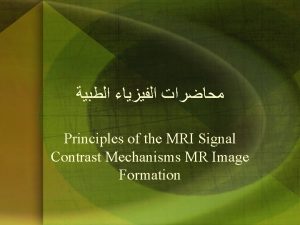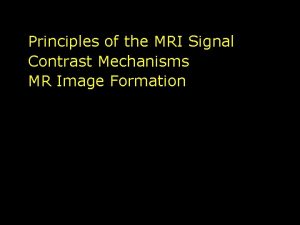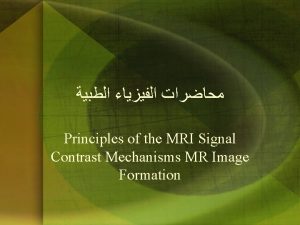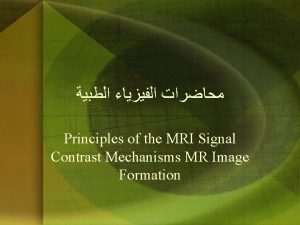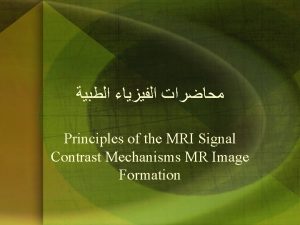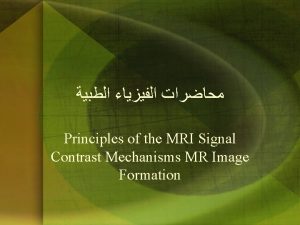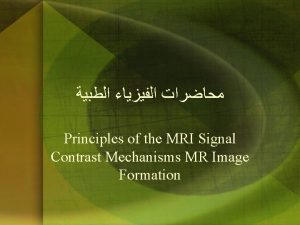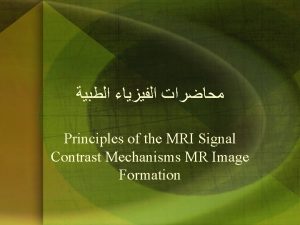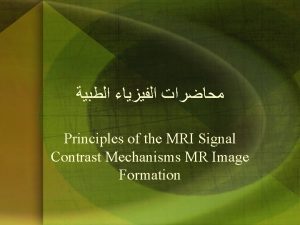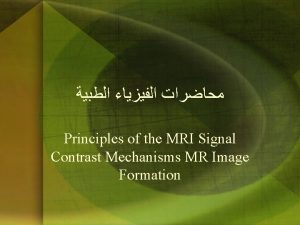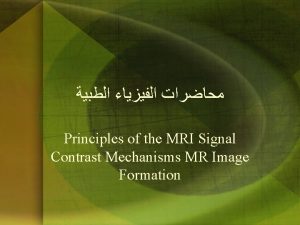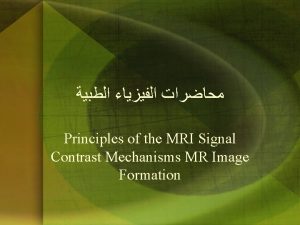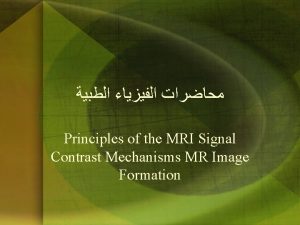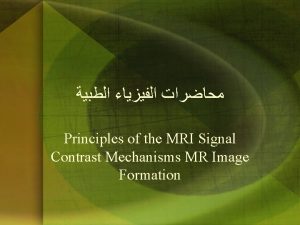Principles of the MRI Signal Contrast Mechanisms MR

















- Slides: 17

ﺍﻟﻄﺒﻴﺔ ﺍﻟﻔﻴﺰﻳﺎﺀ ﻣﺤﺎﺿﺮﺍﺕ Principles of the MRI Signal Contrast Mechanisms MR Image Formation

Contrast Principles of the MRI Signal MR Image Formation Mechanisms ﺍﻟﻤﺤﺎﺿﺮﺓ ﺍﻻﻭﻟﻰ ﺳﻌﻴﺪ ﺳﻠﻤﺎﻥ ﻛﻤﻮﻥ. ﺩ. ﻡ. ﺃ : ﺍﻋﺪﺍﺩ ﺍﻟﺮﺍﺑﻌﺔ ﺍﻟﻄﺒﻴﺔ– ﺍﻟﻤﺮﺣﻠﺔ ﺍﻟﻔﻴﺰﻳﺎﺀ ﻗﺴﻢ - ﺍﻟﺠﺎﻣﻌﺔ ﺍﻟﻌﻠﻢ ﻣﺪﻳﻨﺔ ﻛﻠﻴﺔ John Van. Meter, Ph. D. Center for Functional and Molecular Imaging Georgetown University Medical Center

Outline • Physics behind MRI • Basis of the MRI signal • Tissue Contrast • Examples • Spatial Localization

Synopsis of MRI 1) Put subject in big magnetic field 2) Transmit radio waves into subject [2~10 ms] 3) Turn off radio wave transmitter 4) Receive radio waves re-transmitted by subject 0 5) Convert measured RF data to image

RECEIVING THE SIGNAL When the protons emit RF signal (Electromagnetic radiation) as they relax, the signal induces a current in the receiving coil and this is the manner in which raw data in MRI is obtained. Recall from physics that changes in magnetic flux induces an electromotive force (i. e. voltage). This physical law (Faraday's law) absolutely runs our 24/7 economy! We couldn't generate electricity efficiently in a large magnitude without this law. Electromagnetic waves have both an electric and magnetic field components perpendicular to each other. When the EM waves strike the receiver coil in the MRI machine, the change in magnetic flux induces a current.

Properties of Electrical Fields S S + N N -

The sourse Fundamental Physics of MR Imaging Figure 1. Electrons flowing along a wire. An electric current in a loop of wire will produce a magnetic field (black arrow) perpendicular to the loop of wire. e− = electron.

Properties of Magnetic Fields S N

What kinds of nuclei can be used for NMR? • Nucleus needs to have 2 properties: – Spin – charge • Nuclei are made of protons and neutrons – Both have spin ½ – Protons have charge • Pairs of spins tend to cancel, so only atoms with an odd number of protons or neutrons have spin – Good MR nuclei are 1 H, 13 C, 19 F, 23 Na, 31 P

Hydrogen atoms are best for MRI • Biological tissues are predominantly 12 C, 16 O, 1 H, and 14 N • Hydrogen atom is the only major species that is MR sensitive • Hydrogen is the most abundant atom in the body • The majority of hydrogen is in water (H 2 O) • Essentially all MRI is hydrogen (proton) imaging

Common nuclei with NMR properties Criteria: • Must have ODD number of protons or ODD number of neutrons. Reason? It is impossible to arrange these nuclei so that a zero net angular momentum is achieved. Thus, these nuclei will display a magnetic moment and angular momentum necessary for NMR. Examples: 1 H, 13 C, 19 F, 23 N, and 31 P with gyromagnetic ratio of 42. 58, 10. 71, 40. 08, 11. 27 and 17. 25 MHz/T. Since hydrogen protons are the most abundant in human body, we use 1 H MRI most of the time.

Magnetic Resonance Imaging + spinning proton Hydrogen protons spin producing a magnetic field A magnetic field • creates an electrical charge when it rotates past a coil of wire • N S bar magnet

Similarity between a proton and a bar magnet

Magnetic Moment B B I L W L F m = tmax / B = IA t=m B F = IBL Force t = IBLW = IBA Torque = m B sinq

A Single Proton There is electric charge on the surface of the proton, thus creating a small current loop and generating magnetic moment m. m + + J The proton also has mass which generates an angular momentum J when it is spinning. + Thus proton “magnet” differs from the magnetic bar in that it also possesses angular momentum caused by spinning.

Angular Momentum mvr = J = mw J m r v

The magnetic moment and angular momentum are vectors lying along the spin axis m = g J g is the gyromagnetic ratio g is a constant for a given nucleus
 Fat signal mri
Fat signal mri Double contrast vs single contrast
Double contrast vs single contrast What is compare and contrast text structure
What is compare and contrast text structure Difference between cake and brownie
Difference between cake and brownie Effect signal words
Effect signal words Comparison contrast signal words
Comparison contrast signal words Quoted words signpost
Quoted words signpost Compare and contrast of cardinal and cedar waxwing
Compare and contrast of cardinal and cedar waxwing Baseband signal and bandpass signal
Baseband signal and bandpass signal Baseband signal and bandpass signal
Baseband signal and bandpass signal Digital signal as a composite analog signal
Digital signal as a composite analog signal What is the product of an even signal and odd signal?
What is the product of an even signal and odd signal? Design principles contrast
Design principles contrast Design principles contrast
Design principles contrast Basic principles of signal reproduction
Basic principles of signal reproduction Hình ảnh bộ gõ cơ thể búng tay
Hình ảnh bộ gõ cơ thể búng tay Ng-html
Ng-html Bổ thể
Bổ thể
